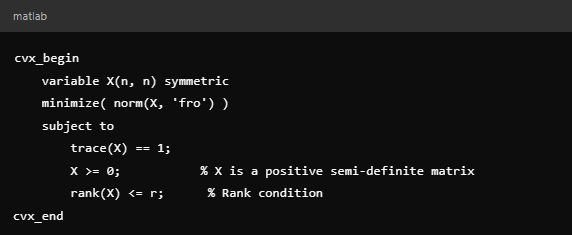When working with convex optimization, implementing rank conditions is an important aspect that often determines whether an optimization problem is feasible or optimal.
Rank conditions, especially in the context of Convex Variable eXpressions (CVX), help refine solutions and model constraints more accurately.
Let’s take a look at the CVX implement rank conditions, what rank conditions are, and why they matter.
What is CVX?
CVX is a modeling system for disciplined convex programming (DCP), designed to simplify the formulation and solution of convex optimization problems.
It supports common problems like linear programs (LPs), quadratic programs (QPs), second-order cone programs (SOCPs), and semidefinite programs (SDPs), while making problem specification easier than using direct solvers.
CVX can also handle more complex convex problems, including those with nondifferentiable functions, like l1 norms. It allows users to solve problems involving norm minimization, entropy maximization, and determinant maximization efficiently.
CVX integrates seamlessly with Matlab, turning it into an optimization modeling language where you can combine standard Matlab code with optimization models. It also offers specific modes for solving semidefinite programming (SDP) and geometric programming (GP) problems.
Rank Conditions In Convex Optimization
In convex optimization, rank conditions refer to constraints on the rank of matrices involved in your optimization problem.
This concept is particularly important in matrix optimization, where the rank can influence the feasibility, optimality, and stability of your solution.
Why Rank Conditions Matter in Convex Optimization
Rank condition matter for many reasons, and they can also have many roles in convex optimization:
- Feasibility: If the rank of a matrix in the constraints is too low, you may face feasibility issues. The feasible region could become larger or smaller than expected, which can influence whether or not a solution exists.
- Optimality: Once a feasible solution is found, rank conditions help determine whether the solution is optimal. They guide the solver to avoid overfitting or underfitting the solution.
- Stability: In numerical optimization, ensuring that rank conditions are met leads to more stable solutions. Without properly addressing rank, solutions might become unstable or inaccurate due to numerical errors.
CVX Implement Rank Conditions: Step-by-Step
Step 1: Defining Matrix Variables
First, you need to define the matrix variables in CVX. Depending on your problem, you may work with symmetric matrices, positive semi-definite matrices, or other specific types of matrices. Here’s how you can declare a matrix in CVX:

Here, X is an n x n symmetric matrix, which is commonly used in optimization problems involving rank conditions.
Step 2: Applying the Rank Condition
Rank constraints can either enforce that the rank of a matrix is less than or equal to a given value or exactly equal to a specified rank.
For example:

In this case, r is the maximum rank for matrix X. This is useful in applications like low-rank matrix approximations, where you’re interested in minimizing the rank while maintaining certain structural properties of the matrix.
Step 3: Solving the Optimization Problem
Once the constraints are set, including the rank condition, CVX can solve the problem using the cvx_begin and cvx_end commands.
For example:

Here, we minimize the Frobenius norm of matrix X, subject to trace and rank conditions. The X >= 0 ensures that X is positive semi-definite, which is common in many optimization problems involving matrices.
Conclusion
Convex optimization problems require stable, optimal, and feasible solutions, and these can only be achieved with the help of rank conditions. It is important to carefully consider how rank interacts with other constraints when implementing these conditions in CVX.
As you continue to hone your model, remember to periodically review your rank conditions. Knowing exactly how rank affects your optimization problem will allow you to explore more sophisticated scenarios and techniques with confidence.
If you liked this article make sure to also throw a look at our other articles on technology themes.




